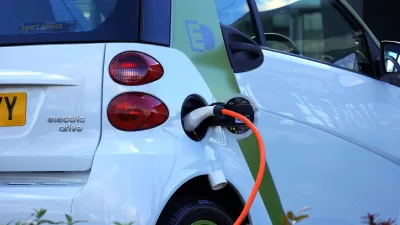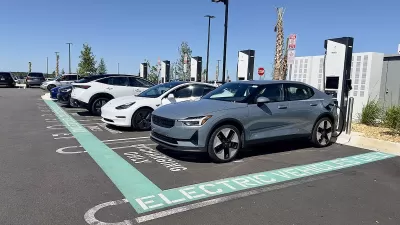The city wants to install a network of more than 3,000 charging stations, with a focus on underserved communities.

"By 2025, the city of Sacramento wants 75,000 zero-emission vehicles on the road, according to a city plan adopted in 2017," writes Isabella Bloom. "It estimates it needs 3,800 charging stations to support that kind of fleet. As of 2020, the city had installed fewer than 700 charging stations," most in dense areas near government offices and freeways. Meanwhile, rural areas and "zip codes with higher percentages of non-white residents" have the fewest charging stations.
Gil Tal, the director of the Plug-in Hybrid and Electric Vehicle Research Center at the University of California, Davis, urges prioritizing these areas. "Disadvantaged communities many times suffer from bad air quality because they are next to traffic routes or next to industry or just less desirable locations," says Tal. "Electrifying these areas are, I think, higher priority, not just because of greenhouse gases, but also because of local air pollution."
While most electric vehicle owners rely on charging their cars at home, "many low-to-moderate-income people who live in apartments or affordable housing may find installing and accessing charging infrastructure is more complicated." Encouraging more widespread EV use in these communities means providing ready access to chargers for residents of multi-unit buildings. "The city recently received a $1.8 million grant from the California Energy Commission that will allow it to provide Level 2 chargers at 13 community centers and libraries, primarily in low-income neighborhoods, including Coloma and Colonial Heights." Sacramento has also introduced an electric car sharing program "to introduce more electric cars and stations to low-income neighborhoods" and passed an ordinance that "will require new nonresidential and multifamily developments to include electric vehicle infrastructure."
Statewide, "[t]he California Energy Commission estimates the state needs 1.2 million public and shared private chargers by 2030 to support the number of electric vehicles expected to be on the road by then."
FULL STORY: Sacramento wants 3,800 car charging stations by 2025. Here’s where they’re needed

Maui's Vacation Rental Debate Turns Ugly
Verbal attacks, misinformation campaigns and fistfights plague a high-stakes debate to convert thousands of vacation rentals into long-term housing.

Planetizen Federal Action Tracker
A weekly monitor of how Trump’s orders and actions are impacting planners and planning in America.

San Francisco Suspends Traffic Calming Amidst Record Deaths
Citing “a challenging fiscal landscape,” the city will cease the program on the heels of 42 traffic deaths, including 24 pedestrians.

Adaptive Reuse Will Create Housing in a Suburban Texas Strip Mall
A developer is reimagining a strip mall property as a mixed-use complex with housing and retail.

Study: Anti-Homelessness Laws Don’t Work
Research shows that punitive measures that criminalized unhoused people don’t help reduce homelessness.

In U.S., Urban Gondolas Face Uphill Battle
Cities in Latin America and Europe have embraced aerial transitways — AKA gondolas — as sustainable, convenient urban transport, especially in tricky geographies. American cities have yet to catch up.
Urban Design for Planners 1: Software Tools
This six-course series explores essential urban design concepts using open source software and equips planners with the tools they need to participate fully in the urban design process.
Planning for Universal Design
Learn the tools for implementing Universal Design in planning regulations.
Heyer Gruel & Associates PA
JM Goldson LLC
Custer County Colorado
City of Camden Redevelopment Agency
City of Astoria
Transportation Research & Education Center (TREC) at Portland State University
Jefferson Parish Government
Camden Redevelopment Agency
City of Claremont





























